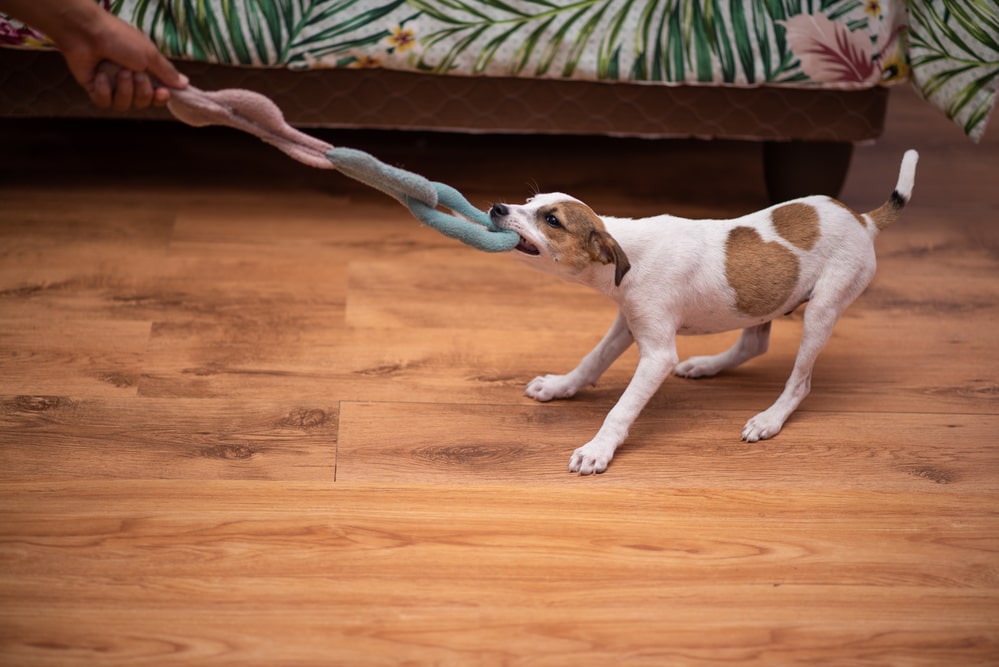
Getting outside to play with your dog can be a challenge. Life gets in the way sometimes, but that doesn’t mean we can let our pups go without daily activity. Inactive dogs are prone to obesity, anxiety, and uncharacteristic behaviors.
Fortunately, you can supplement in-home activities on those days that getting outside just isn’t an option. We’re going to look through some exercises for dogs at home. We hope the ideas below give you a little food for thought on ways you can stay active with your dog without ever leaving the house.
Let’s get started.
1. Teach Your Dog Some New Tricks
Now is a great time to sharpen your skills as your dog’s trainer by learning the basics of positive reinforcement-based training to teach your dog some new tricks. Plus, the mental stimulation of training can help keep your dog from bouncing off of the walls with boredom during your unplanned stay-cation.
You don’t need fancy equipment or expensive dog treats: Just use your dog’s regular kibble rations mixed with a little something extra such as cooked chicken or some small cubes of cheese to make sure he stays extra motivated to learn.
Here are a few tips for making the most of your training sessions while stuck home with your dog during the coronavirus outbreak:
Set Clear Criteria, Then Raise the Bar
Professional dog trainers use the word “criteria” to define the behavior they are looking for before rewarding the dog. Great trainers know that you need to set the bar low at first, raising it after the dog is showing an 80% success rate.
For example, the first criteria for a “sit” might be the instant your dog’s butt touches the ground. However, once she has mastered a 1-second sit, it is time to raise the criteria for reward to a few seconds of sitting. Add distance, duration, and distractions by raising the criteria at a rate that keeps your dog set up for success.
Use a Marker Sound or Word
Clicker training is all the rage in dog training these days. However, you don’t need a clicker in order to make use of this strong behavioral conditioning method of dog training. Instead, just use a special sound or word to “mark” when your dog gives you whatever you have set as your criteria.
Always offer the food reward after the marker sound, even if you made a mistake with your timing.
Start with Nonverbal Cues, Transition to a Verbal Command After the Trick is Learned
Most dog trainers will use a technique known as “luring” to first give a dog some hints as to what behavior they are looking to reward. Often the lure movement, such as bringing a treat down to the floor and ahead of the dog for a “down” is then shorted to a hand signal for the ultimate cue for the trick.
If you stick to a hand signal while training the command, and add the verbal cue only after your dog has learned the trick, it increases the power of the verbal command by associating it with clear success for your dog.
A Few Fun Tricks to Teach Your Dog:
- Sit
- Stay
- Down
- Shake
- Spin
- Stand on the hind legs
- Beg
- Pray
- Bow
2. Indoor Obstacle Course to Keep Dogs Busy
Building an indoor obstacle course for active dogs is a great way to get the kids involved in a fun dog activity that will help everyone get some exercise. If you have a backyard, then this is certainly a game you can play outside.
However, you can also make great use of a long hallway, playroom, or even the family room to set up your doggie obstacle course. Practice each obstacle alone until your dog has mastered them, using the positive reinforcement techniques mentioned above. Then, string them together into a course that has infinite variations.
Here are a few ideas for indoor dog obstacles for your homemade agility course:
Jumps: Use everyday items lying around the house to build jumps for your dog to go over. Using a hallway is a great way to teach your dog to jump the obstacles since they can’t opt to go around them on either side.
Tunnel: A few sheets and some ingenuity and you can make the classic tunnel for your dog to navigate. Start with a short tunnel and use lots of praise and reward. Add length to the tunnel once your dog has comfort with the basics.
Down Mat: A simple small rug will work well as a down mat on your obstacle course. Work on getting a fast down and hold for 3 seconds before going to the next obstacle on your course.
Crawl: Use a pole (think broom handle or some other long item) to create a “crawl under” obstacle.
Platform: Create a stable platform or use existing furniture to create a sit platform for your dog.
3. Hide and Seek
Hide and Seek is a fun game to get the kids involved in. It also has the benefit of teaching your dog a strong recall, an important and potentially life-saving skill to teach your dog to come when called.
For this game give everyone a small bag of kibble laced with a few extra-tasty treats your dog loves. Then, take up different positions in the house and take turns excitedly calling your dog followed by praise and a treat for success.
If your dog is new to coming to her name, try starting in the same room standing in a circle, then gradually make the game more difficult by going into different rooms and even looking for some hiding spots to add even more challenge.
Another exploratory game that dogs love is the use of a food puzzle. These devices withhold food from the dog until they solve a puzzle. It’s a great way for
4. Find it!
This is a great exercise to help your dog get both mental stimulation and some low-impact physical exercise for either rainy days or just to have some fun indoors during the coronavirus crisis.
The options for what to play this game with depend on your dog.
Do they have a favorite tug, ball, or tug they go crazy for? If so then hiding this toy and then playing with it for a few minutes as a reward for finding it is one way to play. For food-motivated dogs, just hiding some kibble around the room is another way to play.
The trick is to have your dog in one room while you hide their toy or treats. Make the game super easy at first, increasing difficulty only after your dog “gets” the point of this game. Dogs love it, and it’s a great version of hide-and-seek.
5. Tug of War
Finally, if your dog doesn’t know the joys of tug-of-war then now might be a great time to teach your dog this fun and rewarding game.
If you don’t have a store-bought tug on hand, don’t sweat it. Find an old T-shirt, cut some fabric into strips and braid it, or even use some cotton rope to braid and knot into a make-shift tug.
The main thing you want to avoid are strands of threads that could be a choking hazard, so avoid materials that quickly turn into dangerous frayed long strands.
Rules of Tug of War
Many dog trainers recommend this game for performance dogs as it can be so rewarding that it serves as a motivator that can be a great alternative to food rewards for positive reinforcement training. However, this game is best played when you teach some healthy boundaries with this game:
- Only play tug when you initiate the game with a verbal cue, such as “Tug it!” Don’t let your dog try to play tug with other items or when uninvited.
- Let your dog win often. It is an old myth that letting your dog win at this game will turn him into some kind of dominant problem dog. No one wants to play a game they always lose. If you want your dog to love this game, let them win around 30% of the time.
- Teach the cue “Drop it” and practice it often when playing the tug game. Your dog needs to learn that you are in control of when this game is played. If your dog fails to drop the tug on command, end the game and try again later.
- If your dog touches teeth to skin at any time, end the game immediately and try again later.

The Team at Lolahemp Wishes the Best for You and Your Furry Friend During These Times!
Here at Lolahemp, we sincerely hope all of our customers and partners are staying safe during this uncertain time. Because our mission is focused on animal welfare, we wanted to help make sure you have lots of ideas to include your canine companion in your stay-at-home plans.
Those lonesome long walks are good, but we hope the indoor exercise ideas above help you fill the time when you’re not able to make it out to the trail. To learn more about Lolahemp, and our inspiration, Lola, we hope you will enjoy one last video:
References:
https://www.youtube.com/watch?v=_droCQsWzgg
https://www.youtube.com/watch?v=jWzbQSP_cNw
https://www.youtube.com/watch?v=IuRRUBALCqY
https://www.youtube.com/watch?v=MJ_OjF5yU5s
https://www.youtube.com/watch?v=U4L8s1PI7pg
https://www.youtube.com/watch?v=1L_oUwC6vjQ

